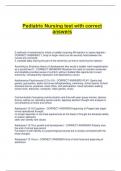Pediatric Nursing test with correct
answers
2 methods of restraining for infant or toddler receiving IM injection in vastus lateralis -
CORRECT ANSWERS-1. body of larger infant can be securely held between the
nurses arm and body
2. swaddle baby leaving the part of the extremity out that is receiving the injection
According to Ericksons theory of development why would a toddler view hospitalization
as a punishment? - CORRECT ANSWERS-Ritualism the need to maintain sameness
and reliability provides sense of comfort. without ritu8als little opportunity to exert
autonomy. consequently regression and dependency occurs
Adolescence Psychosocial (12 to 18) - CORRECT ANSWERS-PLAY: Sports-ball
games, gymnastics, water and snow skiing/boarding, swimming, school sports. School
activities-drama, yearbook, class office, club participation. Quiet activities-reading,
school work, television, computer, video games, music.
Communication Increasing communication and time with peer group-movies, dances,
driving, eating out, attending sports events. Applying abstract thought and analysis in
conversations at home and school
Adolescent 12-18 Cognitive - CORRECT ANSWERS-beginning of Piagets last stage-
formal operational thought;
no longer depends on concrete experiences as the basis of thought but develops ability
to reason abstractly
seek own identity and values
Adolescent 12-18 yr growth and development - CORRECT ANSWERS-Puberty near
the end of school age period;
Formation of self identity is a psychological process but is closely connected with the
body changes.
Adolescent 12-18 yrs - CORRECT ANSWERS-End of child hood and beginning of
adulthood
,Adolescent growth and devel milestones - CORRECT ANSWERS-growth varies; girls
spurt gain 15-55 lbs; grow 2-8 in
boys spurt: gain 15-65 lbs and grow 4 1/2- 12 inches
Skills well developed (fine motor)
new sports activities attempted and muscle development continues
some lack of coordination (common during spurt)
Sensory ability- fully developed
Authoritarian - CORRECT ANSWERS-High control, low warmth
Highly controlling/expect to be obeyed/little communication
permits little independence
Child outcome:
no negotiation skills, no ability to direct and initiate own activities, frustrated in efforts to
achieve autonomy, girls passive, boys aggressive
authoritative - CORRECT ANSWERS-Moderately high control, high warmth
sets reasonable limits on behavior
accepts and encourages growing autonomy
open communication
flexible rules
Child outcome: willingly excepts restriction, more self reliant, self controlled, socially
competent, better school performance
Autonomy vs Shame and doubt - CORRECT ANSWERS-1-3 yrs Toddlers sense of
autonomy or independence si shown by controlling body excretions, saying NO, and
directing motor activity
Children who are consistently criticized for expressions of autonomy or for lack of
control (ex toilet training) will develop a sense of shame about themselves and doubt
their abilities
Cephalocaudal development - CORRECT ANSWERS-development that proceeds from
the head toward the feet
Common defense Mechanisms used by children - CORRECT ANSWERS-Regression-
return to early behavior
Repression- involuntary forgetting of uncomfortable situations
rationalization- attempt to make unacceptable feelings acceptable
fantasy- creation of the mind to help deal with unacceptable fear
Concrete operational (Piaget) - CORRECT ANSWERS-7-11 yrs
Transductive reasoning to a more accurate understanding of cause and effect.
Conservation: matter does not change when form is altered learned at this age.
, Developmental Age groups - CORRECT ANSWERS-Infancy- birth to 12 months
high level of care in daily activities
Toddlerhood- 1-3 years. increased motor ability and independent behavior
Preschool- 3-6 years. the preschooler refinees gross and fine motor ability and
language skills and often participates in a preschool learning program
School age- 6-12 years. begins with entry to school sys. growing intellectual skills,
physical ability, and independence
Adolescence- 12-18 years. begins with entry into the teen years. Mature cognitive
thought, formation of identity, and influence of peers import characteristic of
adolescence.
Developmental approach to EXam adolescents - CORRECT ANSWERS-• Provide for
adolescent's modesty by providing a private place to undress/dress.
• Perform without parent/sibling unless adolescent requests them.
• If parent/sibling not present, provide a chaperone during exam.
• Keep body covered with gown except when assessing that area.
• Use head-to-toe and same procedures as used for adults.
• When appropriate provide reassurance about secondary sexual characteristic
development, and what further changes to expect.
Developmental approach to EXam NB to 6 months - CORRECT ANSWERS-• Keep
parent present to provide security to infant.
• Keep sequence of exam flexible.
• Provide physical comfort during exam (feeding, pacifier, cuddling, changing diaper.
• Distracting by rocking or clicking noises if begins to get distressed.
• Auscultate when infant is quiet or asleep.
Developmental approach to EXam over 6 months - CORRECT ANSWERS-• Keep older
infant with parent (prevent stranger anxiety). May be afraid of being touched
• Start with feet or hands before moving to trunk to decrease fears.
• Examined on parent's lap (also use of therapeutic hug).
• Won't object to having clothing removed (keep room warm).
• Smile & talk soothingly to infant, use toys to distract older infant.
• Use bottle or pacifier to quiet child when necessary.
Developmental approach to EXam preschoolers - CORRECT ANSWERS-• Assess
willingness of child to be separated from the parent.
• Most children are willing to undress, but leave underpants on.
• Most children this age are cooperative with exam.
• Allow child to touch and play with equipment.
• Give simple explanations about assessment procedures.
• Allow choices when possible.
• Use distraction to gain child's cooperation (ask child to count, name colors, etc).
• Give child positive feedback when they cooperate.




